Information on Growing Old Fashioned Garden Phlox
Phloxes: planting and care, growing from seeds
Content
- Description of phlox flowers
- Types and varieties of phlox
- Annual phloxes
- Perennial phloxes
- Garden phlox
- Growing of phlox from seeds
- Annual phlox – planting and care
- Planting of annual phlox
- Care of almanac phlox
- Diseases of phloxes
- Pests of phlox
- Perennial phlox – planting and care
- Planting of perennial phlox
- Care of perennial phlox
- Phloxes in wintertime и после цветения
- References and links
- Comments
 Phlox (lat. Phlox) is a genus of herbaceous plants in the family unit of Polemoniaceae that includes about seventy species and near forty of them are cultivated. In Europe phlox was brought in the centre of the 18th century, since then breeders have created about ane,500 varieties of cute and fragrant flowers. Phlox is a Greek word meaning "flame". This name was given to the plant by Carl Linnaeus in 1737 as the flowers of some species are extremely bright.
Phlox (lat. Phlox) is a genus of herbaceous plants in the family unit of Polemoniaceae that includes about seventy species and near forty of them are cultivated. In Europe phlox was brought in the centre of the 18th century, since then breeders have created about ane,500 varieties of cute and fragrant flowers. Phlox is a Greek word meaning "flame". This name was given to the plant by Carl Linnaeus in 1737 as the flowers of some species are extremely bright.
Phlox is native to North America and its harsh climate fabricated this plant like shooting fish in a barrel-to-grow and tenacious. In addition, phloxes are very fragrant and bloom for a long time.
Clarification of phlox flowers
Description of phlox flowers Even belonging to one species phloxes tin can be very diverse: their await changes depending on the climate in which they grow. For instance, at an altitude of 2.5 miles they are moss-like and depression-growing, their stems are branching and covered with evergreen leaves, and the pinnacle of plants is from 2 to 10 inches. In more than favorable conditions, phloxes are upright shrubs with a height of 11.8 inches to 6 ft. And phloxes can exist one-half-shrubs. Phloxes are classified past the time of flowering: they are spring (early on), summer (mid-flavour) and summertime-fall (belatedly). The varieties of upright-growing phloxes are cultivated most of all. Their leaves are sessile, opposite, unabridged, oval-lanceolate or elongate-ovoid. Flowers of phloxes are from 1 to one.6 inches in diameter, have a tubular funnel-like shape and are collected in circuitous inflorescences up to 90 pieces in each. The flowers accept v bent petals, five stamens and one pestle. The fruit of phlox is an oval capsule. All cultivated phloxes are perennial plants, and only Drummond'southward phlox (Phlox drummondii) and its numerous varieties are almanac.
Types and varieties of phlox
Annual phloxes
Drummond'due south phlox is one of the best annuals among the garden flowers. Being discovered in Texas, it was brought to England by a Scottish traveler, naturalist and theologian Thomas Drummond in 1835. In England the blossom took root. Drummond'southward phlox blooms from June till the frosts. Its leaves are oval-lanceolate, opposite. Sparse branched stalk is from 4.7 to 11.8 inches high. Fragrant flowers are violet, dark red, white, yellow, salmon.
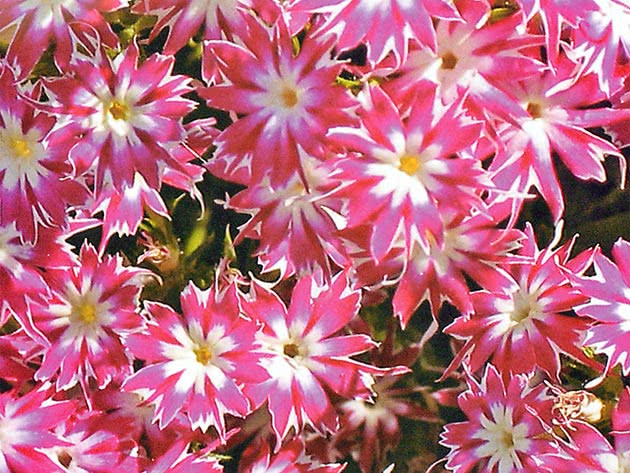 Drummond'southward phlox
Drummond'southward phlox
Drummond's phlox is represented past two types: star-shaped and large-flowered. ФStar-shaped Drummond'due south (Phlox drummondii cuspidata) usually reaches 11.viii-fifteen.vii inches in acme, although depression-growing (upwards to 4.7 inches) varieties are known. The petals of its brilliant flowers are beautifully dissected, and the flowers expect like a star with an heart. Large-flowered Drummond's phlox (Phlox drummondii mixed) grows upwardly to 11.viii inches in height. It has large flowers of dissimilar colors, but red flowers are especially attractive.
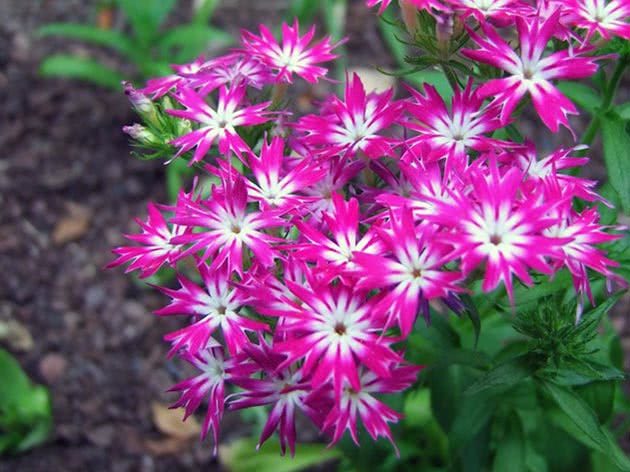 Drummond's phlox
Drummond's phlox
Some growers allocate almanac phloxes by their size into large-flowered and dwarf (half dozen-7.8 inches tall). Among the big-flowered varieties there are Loftier White, High Fiery Cherry and Loftier Bright Red. Compact low-growing varieties (dwarf varieties) are represented past Snowball (white), Shamoa (pinkish), Isabella (yellow), Salmona (salmon), Defiance (peppery red). Both large-flowered and star-shaped types accept double and semi-double varieties. Promise is a pop diverseness of double phloxes.
Perennial phloxes
Among perennial varieties of phlox creeping phlox (phlox subulata) is the starting time to bloom (in May). The flowers of different shades from snowfall-white to nighttime-scarlet heavily embrace densely branched stems and completely hide that leaves that are narrow, awl-shaped (the Latin word from its proper name "subulata" ways "needle-shaped"). This variety of phlox is planted in rock gardens and on alpine hills. Wide blue phlox too blooms in May, 1 or two weeks later. Its lilliputian bushes with delicate lilac-bluish flowers look very elegant. This species is not so sun-loving as creeping phlox. It has lignified stems, larger, but less dumbo leaves. Perennial phloxes are also represented by such species equally garden phlox, blooming in the middle of summer. This is a well-known phlox with huge fragrant heads of flowers and cute dark-green leaves.
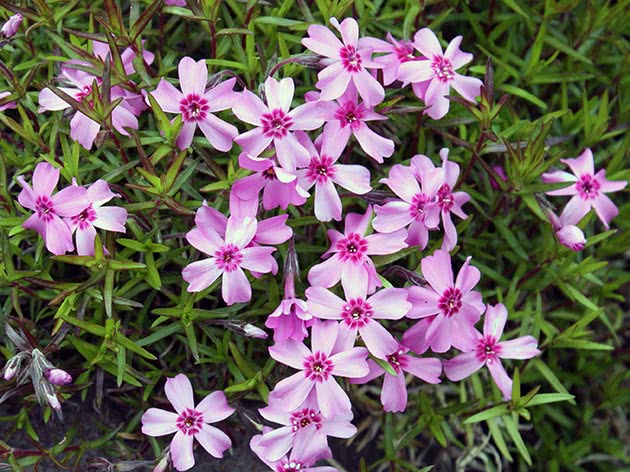
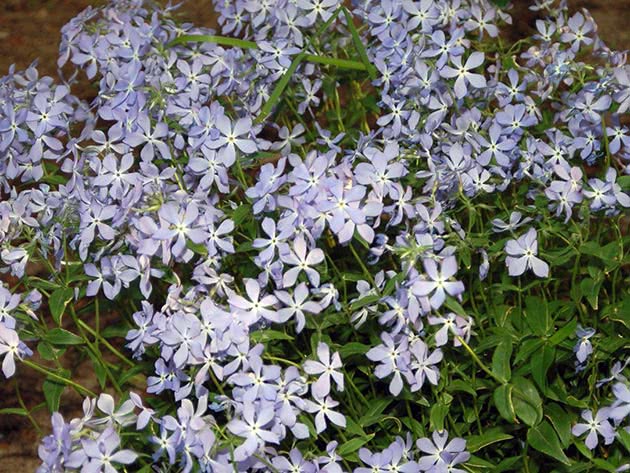
Garden phlox
is the ancestor of many exquisite varieties, amid which in that location are double phlox Pure Feelings (big inflorescences of white flowers with a greenish stripe in the center, the underside is lilac; petals are elongated, twisted, the height of the institute is ii.3-2.half-dozen ft) and double phlox Natural Feelings (very small white-green-pink flowers, inflorescences resemble a co-operative of lilac). The result of the selection piece of work is such winter-resistant varieties as phlox Orangish (Orange Perfection, Orange Spat) of orange-red shades that do not lose effulgence in the sun. It is like shooting fish in a barrel to breed and care for them. They are incredibly beautiful. But curiously enough, the nearly popular diversity amid the florists is phlox King, upwards to three.iii ft high with flowers up to ane.6 inches in diameter, in colors of reddish, pink, lilac, white and other.
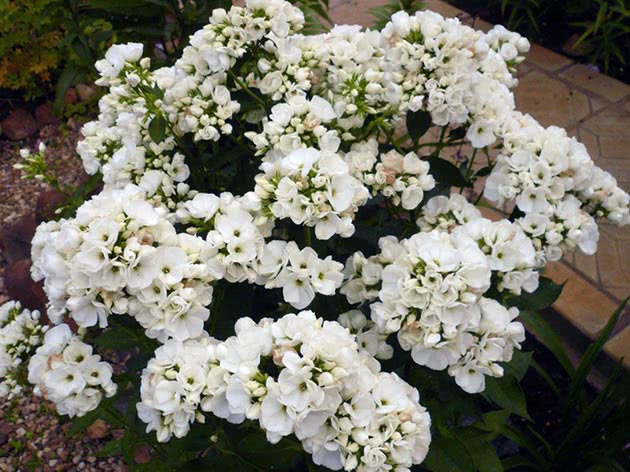
Growing of phlox from seeds
Information technology is possible to take flowering phlox in the garden from spring till the end of September, you just need to know how to abound phlox. Phloxes are mostly propagated vegetatively through cuttings, layers or bush sectionalization, but some growers adopt growing of phlox from seeds. Seeds of perennial phlox, collected on the eve of autumn, must be sown in the ground before winter in November-December. Choose a planting site where your phlox will grow for several years. If at that place is already snowfall on the site, remove it from the garden and sprinkle seeds over the frozen ground at a distance of 1.6-2 inches. Sprinkle a 0.4-0.6 inch layer of sifted soil over the seeds, and embrace information technology with snow. The soil can be prepared in advance, so it will not be cold and frozen, or you lot can buy the soil in the store. The germination of seeds sown in winter is seventy%, by spring their germination capacity sharply decreases. Early on in bound sprouts will appear that volition need to be pricked out after the appearance of two pairs of true leaves at a distance of vii.8 inches from each other. Y'all will plant out these seedlings in due time.
More often than not annual phloxes are propagated past seeds. In leap, prepare a bed, sprinkle seeds i.2-1.6 inches autonomously, water them from a sprayer, comprehend them with polyethylene. Practice not sprinkle the soil over them, but every day, elevator up the foil for a short while, shaking off the condensate from information technology, and so that the seeds can breathe. Once the seeds are sprouted, the polyethylene can be removed.
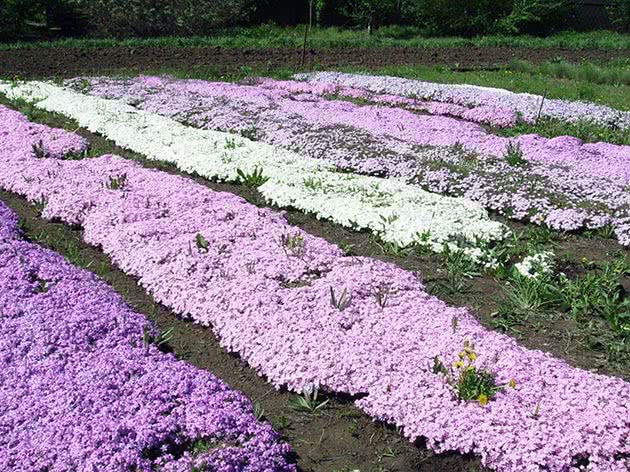
Annual phlox – planting and care
Planting of annual phlox
Nosotros take already described how to grow phlox from seeds. But some growers do not want to expose the seeds to hazard for fear of strong jump frosts, so they constitute seedlings of phlox in bound. To get seedlings the seeds of phlox are sown in March, the sprouts appear in a week. Sprouted seedlings need lite, watering and a moderate temperature. In 2 or three weeks the shoots are pricked out. In the beginning days after pricking, try to protect the shoots from direct sunlight in order to avoid burns. Cover them with a paper or an opaque foil. Before planting of phlox seedlings in the open ground, you should feed the seedlings with mineral fertilizers two or iii times. The concentration of fertilizing solution should be 2 times weaker than for an adult constitute. To promote bushier growth at the phase of 4-v leaves the shoots are pinched.
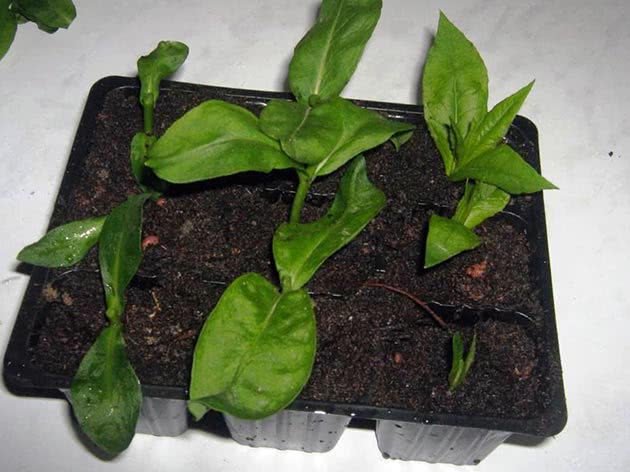
In May, the grown-upwards seedlings of phlox are planted out on the bed at a distance of 6-7.8 inches from each other. It is very important to choose the correct place for planting. Annual phloxes are cold- and drought-resistant, dearest light, simply practice not tolerate overheating of the root system. The near cute phloxes grow in the dappled shade, and the thicker the shade is, the less arable but the longer the phlox flowering is. In the lord's day, the flowers of phlox chop-chop lose their brightness; in the fractional shade they keep the color strength for a long time, and if you institute the so-called "bluish" varieties the flowers of which become about blue in the twilight, y'all will get an incomparable aesthetic pleasure from the phloxes grown in the fractional shade. It is the all-time to plant phloxes on high beds, far away from copse and shrubs with a highly branched root system.
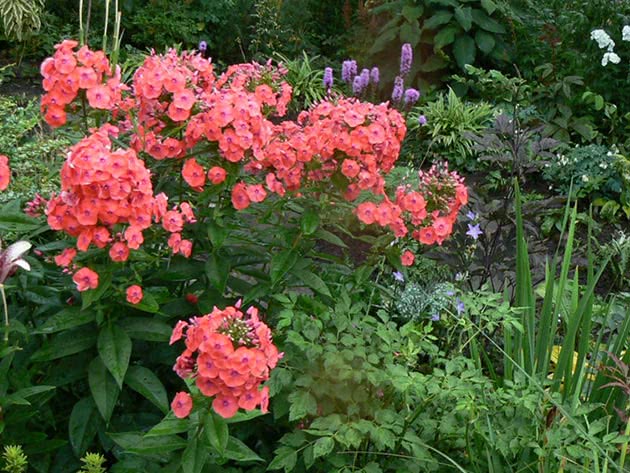
Garden soil for phloxes should incorporate a large amount of humus. Heavy soils with poor drainage are fatal for phlox. They do not like acidified areas, in this case lime volition demand to be added to the soil. The best composition of the soil for phlox is fertile sand without clay impurities, with an adequate watering. This will let you grow powerful flowering bushes. If the soil is heavy loam, you will have to add sand, organic fertilizers and peat into it. Add bio-humus or compost (or two handfuls of ash) into the planting pigsty, constitute a phlox seedling with the roots straightened horizontally.
Care of annual phlox
Growing of annual phloxes is a pleasant and easy-to-do chore. The primary affair is not to stop them from growing. The residuum of the intendance is cautious loosening of the soil (6-8 times) that is usual for all flowers, earthing up during loosening in the second half of the growing season for the root system of phloxes to get formed quickly, feeding with organic and mineral fertilizers. The first top dressing with liquid manure (0.9 oz per bucket of water) is carried out at the end of May. The second is in early June, just potassium common salt or superphosphate should exist added to the solution of manure. The 3rd ane (liquid manure without additives) is in the beginning of July. The fourth elevation dressing takes place at the cease of July and should comprise phosphorus and potassium salt.

Phloxes need a regular and moderate watering in the morning or in the evening. It is necessary to pour h2o under a root at the rate of 1.5-2 buckets per 11ft². It is fatal to h2o phlox with cold water in the daytime estrus, because the stems tin crack. It is advisable to remove spent flowers that prevent the growth of the new ones. As for diseases and pests, phlox have plenty of them.
Diseases of phloxes
Such a illness equally Alfalfa mosaic causes an unusual pattern on the petals of phloxes, disfiguring the appearance of the plant. In that location is no remedy for this disease, and then the bush is dug out and destroyed in order to preclude the disease from spreading. The same sentence will have to be carried out if it is found that the constitute was affected past powdery mildew, a fungal disease, that covers the leaves and stems with whitish deposit.
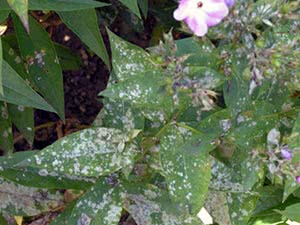 Phloxes endure from i more fungal illness such as phoma leaf spot that makes the shoots brittle and the leaves dry. As a preventive measure out, it is suggested to spray colloidal sulfur on the leaves and stems of phlox (not on the inflorescences), simply the air temperature should be at to the lowest degree 64 °F. Septoria blight manifests itself as dark brown spots on the leaves of plants that increase in size with the evolution of the affliction. At the first signs, sprinkle the bush and the soil around information technology with Bordeaux mixture, and in two weeks repeat the treatment. Some other disease, verticillium wilting, destroys the root system of phlox, simply only phloxes growing on acidic soils endure from information technology.
Phloxes endure from i more fungal illness such as phoma leaf spot that makes the shoots brittle and the leaves dry. As a preventive measure out, it is suggested to spray colloidal sulfur on the leaves and stems of phlox (not on the inflorescences), simply the air temperature should be at to the lowest degree 64 °F. Septoria blight manifests itself as dark brown spots on the leaves of plants that increase in size with the evolution of the affliction. At the first signs, sprinkle the bush and the soil around information technology with Bordeaux mixture, and in two weeks repeat the treatment. Some other disease, verticillium wilting, destroys the root system of phlox, simply only phloxes growing on acidic soils endure from information technology.
Pests of phlox
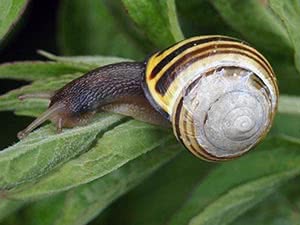 More often than not phlox is attacked by nematodes, a tiny thread-similar worm that sips the sap. Inflorescences go disfigured, flowers get smaller, the stems get thinner. The afflicted bush will accept to be dug out and burned, and the contaminated soil should exist treated by nematicides three times with an interval of twenty days. Phlox tin can get harmed with state slugs, eating the lesser of the stems, leaves and even flowers at nighttime. They live in the upper layers of the soil, and so the preventive loosening of the soil and weeding will exist quite constructive means of fighting with slugs, simply if they did appear on the site, dust the soil with slaked lime, ash or a mixture of ash and tobacco grit. If phloxes are damaged by butterfly caterpillars, information technology is amend to collect them manually, but if there are too many of them, then treat phlox with pesticides for leaf-eating pests.
More often than not phlox is attacked by nematodes, a tiny thread-similar worm that sips the sap. Inflorescences go disfigured, flowers get smaller, the stems get thinner. The afflicted bush will accept to be dug out and burned, and the contaminated soil should exist treated by nematicides three times with an interval of twenty days. Phlox tin can get harmed with state slugs, eating the lesser of the stems, leaves and even flowers at nighttime. They live in the upper layers of the soil, and so the preventive loosening of the soil and weeding will exist quite constructive means of fighting with slugs, simply if they did appear on the site, dust the soil with slaked lime, ash or a mixture of ash and tobacco grit. If phloxes are damaged by butterfly caterpillars, information technology is amend to collect them manually, but if there are too many of them, then treat phlox with pesticides for leaf-eating pests.
Perennial phlox – planting and intendance
Planting of perennial phlox
Growing of perennial phlox is non much unlike from growing of annual phloxes, only still in that location are some points. For case, the spring planting of perennial varieties is carried out in the same manner as of the annual ones, but after that the planting site must be mulched with dry peat or humus. In add-on, the distance betwixt plants should not be 6-vii.viii inches, but at least 1.6 ft, because the phloxes volition grow on this site for many years, and they will need a room to grow. If you purchase phloxes in autumn, then do non establish them at one time, but slightly cover them with soil to a depth of half dozen-10 inches on the site protected from the air current with much snow in winter. Once the soil freezes, comprehend the phloxes with peat or dry out leaves.

In addition, in some cases planting of perennial phloxes is carried out in autumn. For example, if the bush has profoundly grown and has lost ornamental beauty, in autumn (from the center of August till the offset ten days of September) dig it out, divide the rhizome, remove the middle of the bush-league that grows old earlier than other parts, and plant out the side parts. Also in fall phloxes grown from the spring cuttings should exist planted on the permanent place. Before the autumn planting, compost is added to the soil; if there is a clay loam, so also add sand; and if the soil is sandy, and then add some peat. At the distance of 1.6 ft from each other cuttings are placed non deeper than 1.6-2 inches with their roots straightened horizontally. If there is no rain, planted phloxes are watered abundantly at the rate of 3.5 pints of h2o per bush every two-three days for 2 weeks, the stale upwards soil is loosened and mulched with 1.half dozen inches layer of peat or humus.
Intendance of perennial phlox
Care for perennial phloxes is the same every bit for annual ones. Just if annual phloxes need to be fertilized four times during the growth period, perennial species are fertilized five times – the last one is in the period when the seeds are formed in the capsules. Phloxes are fed with potash phosphorus fertilizers (0.4 oz of potassium sulfate and 0.eight oz of superphosphate per a bucket of h2o). Do this in the evening after watering, avoiding the leaves. With proper intendance and expert feeding, phloxes grow on one place, without losing ornamental beauty, for up to seven years.
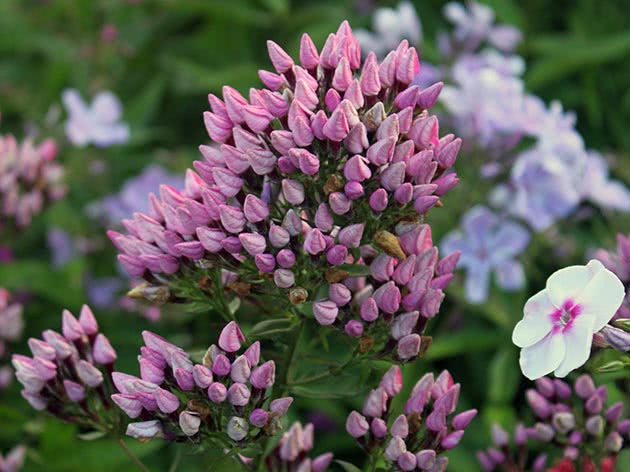
Perennial phloxes are one of the rarest cultures that produce cuttings during the entire growing season. You can outset from the moment when the shoots are 2 inches long, the last cuttings are made at the finish of September. You should keep in mind, however, that spring and summer rootings are more successful than afterward ones. In addition to propagation from cuttings, phloxes are propagated by layers, and this method is much less labor-consuming than cuttings. The stem before fading is aptitude to the ground, fixed along the entire length and covered with humus and peat. In autumn a new plant is formed past this shoot, it is separated from the main bush-league and transplanted to where it will grow permanently.
Phloxes in winter и после цветения
Almanac phloxes tin can bloom the side by side year, but the quality of the inflorescence is unlikely to be high. Therefore, if you desire, collect the seeds, cut off the dead leaves in autumn, and dig upward the ground on the site, removing the rhizomes of phloxes from it. In spring you will exist able to sow the collected seeds, and the flowers yous like will bloom again.
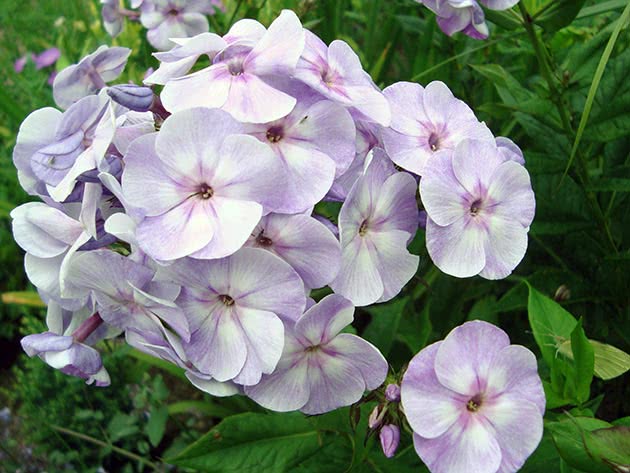
Perennial phloxes, or rather their growth buds, tin freeze in the snowless winter if the temperature drops to 14-5 ºF, and if the frost reaches -four -13 ºF, the rhizome of phlox will die. Therefore, in autumn, later on the leafage of the phlox has yellowed and withered, cut information technology off, and sprinkle the root collars with a layer of soil with peat. Cover them with straw, fallen leaves or fir twigs to protect the rhizomes in the footing until the spring. If in that location is an 1.6-two ft layers of snow, then you can non be agape of -22 ºF frost.
References and links
- Read as well about topic at Wikipedia
- Features and other plants of the family Polemoniaceae
- List of all species on The Plant List
- More than data at Earth Flora Online
After this article is usually read




0 Response to "Information on Growing Old Fashioned Garden Phlox"
Post a Comment